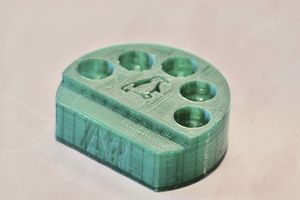
Designer
Jorden Senior' PICO Group, Low Temperature Laboratory Department of Applied Physics Aalto University
Project
In the PICO group, we have a number of home-built plastic He-3/He-4 dilution refrigerators, capable of cooling nanoelectronics to 40 mK temperatures, to perform thermodynamics and quantum phenomena experiments. See More Here
One of these plastic dilution refrigerators is equipped with RF lines for doing RF experiments, and the stages to mount chips in this refrigerator have lines that break out to standard SMA connectors on the bottom of the stage for easy installation in the fridge. Unfortunately, this makes them difficult to handle outside of the fridge, so a solution is required.
This project was performed as a final project of the L3999 course Fall 2017.
Model
Concept
The SMA connectors on the stages are not completely rotationally symmetric, due to the needs of the breakout. Additionally, there is a screw mount on the stage for affixing the stage to the refrigerator without relying on applying stress to the RF connectors. This is, due to limitations in the refrigerator design, not equal height to the connectors, and a DC breakout connector is again at another height - so the support structure for holding the stages must have different levels to support different features.
SMA connectors are expensive, and easy to break - especially the threading. So the holes for the connectors incorporate a larger-than-required hole for pre-alignment, followed by a tapering to auto-align the stage into the holder. Positioning was done by measuring the dimensions of the sample stage structures. Logos for the LTL (Penguin) and Aalto University are added to inspire the chip into working, but will not be visible to the operator when the holder is in use.
Bill of Materials
- Holder
Estimated Cost
$0.55
The costs have been calculated using a price of $25 per 1 kg for PLA [1] and 22 g PLA consumption (estimated by Cura slicer).
This is a custom device, so main cost would be labour of a mechanical engineering technician, and materials. 2 holders were printed at Aalto Fablab, with zero expense for materials or labour.
Directions
1) Download the files from the NIH repository.
2) Print in one run, using 3D printer of choice. High resolution not required.
Planned upgrades
- Grounding solution
Final Prints
All components have been printed using LulzBot Mini printer and PolyLite PLA material at Aalto Fablab. The print speed was set to 50 mm/s, and a layer height of 0.25 mm was used, at 30% infill. A printed brim was utilised, although may not be required.
-
Final print
-
Unloaded holder at a protestation
-
Normal operating situation
-
The sample stages that the holder is designed for



